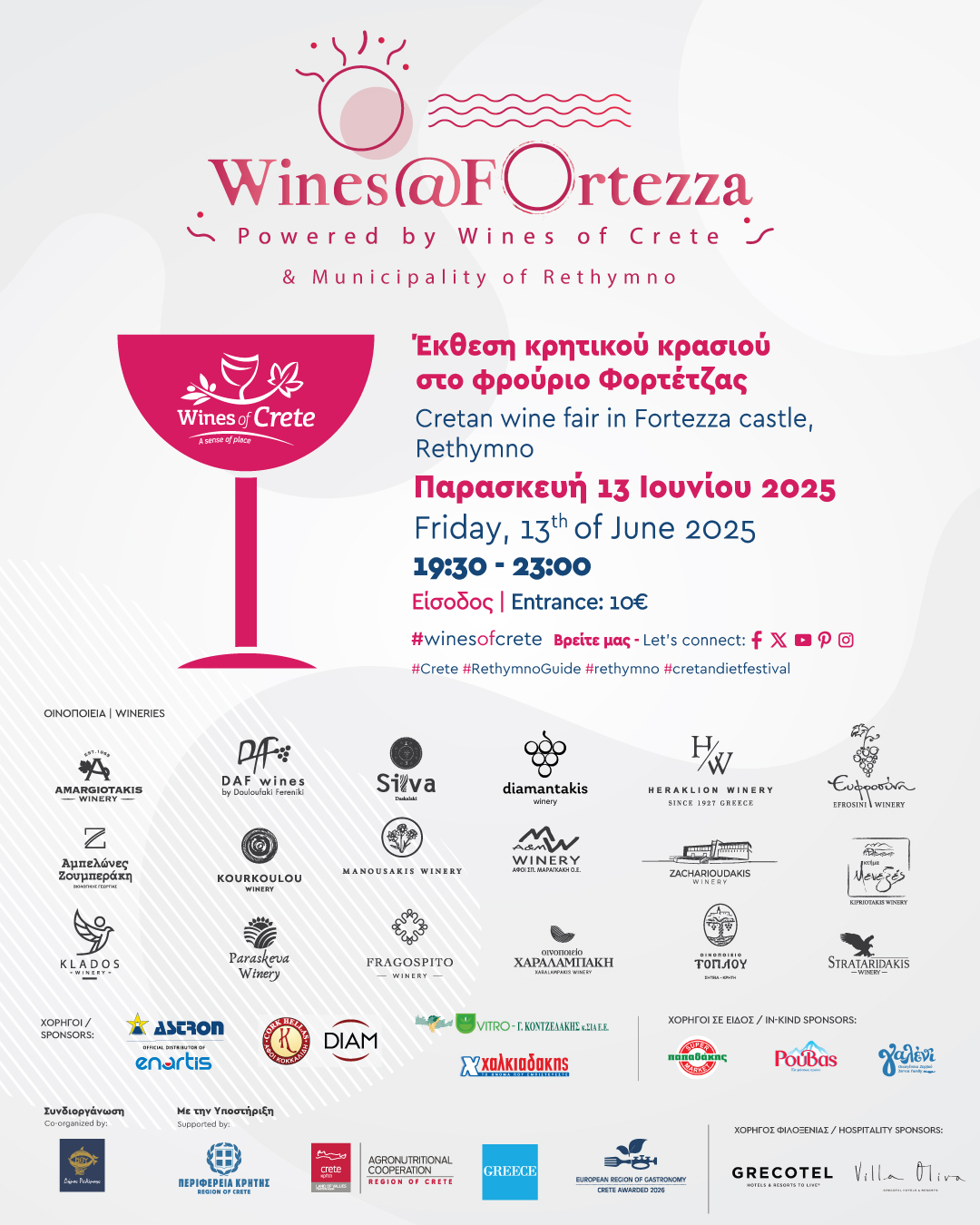The island of Crete is home to many indigenous grape varieties, some of which undoubtedly derive from those grown by the Minoans over four thousand years ago. We recently visited Crete to meet the winemakers, tour the vineyards, and taste the wines, including fresh-tasting rosés made from the island’s indigenous grapes. We also visited the Minoan Knossos Palace where this mural was discovered. In this article we present selected rosé wines and the winemakers who made them. Unfortunately, many of these wines are not widely distributed in the US. All the more reason for wine lovers to do a post-Covid trip to Crete and for US importers to seriously consider adding more of these excellent producers and wines to their portfolios. A full IWR report on The Wines of Crete is forthcoming later this year.
Grapes for Rosé in Crete
Kotsifali and Liatiko are the two indigenous varieties most commonly used for making wine on Crete, but other varieties like Mandilaria and Muscat of Spinas, and international varieties like Mourvédre and Syrah are also used. Liatiko, an early maturing, light colored grape, is the most widely planted red variety in Crete. The Liatiko rosés we tasted from Kourkoulou, Louloudis and Lyrarakis are all first rate wines. Kotsifali is thin skinned, high in alcohol and low in acidity, but when picked early for rosé and direct pressed, it can produce fresh tasting wines. It’s often blended with other varieties. The Harabalakis rosé adds the Mandilaria grape, which adds both color and acidity.
Ancient Rosé?
The wines of Minoa were probably light in color and consumed young and fresh, not greatly different from today’s rosés and orange wines. The Minoan palace at Knossos on Crete had underground storerooms where large, sunken clay jars stored wine and other foodstuffs. Later on during the Roman empire, sweet Cretan wine was exported throughout the Mediterranean, and Vino di Candia from Crete was widely exported in the medieval ages.
The Wines
DAF Wines 2021 White Earth Rosé PGI Crete 89 Light copper salmon in color, this is a very dry, nicely balanced rosé that would pair well with a variety of vegetable and fish dishes. The palate has good weight and a chalky texture with blood orange and red berry nuances. An 80/20 blend of Muscat of Spinas and Liatiko made saignée style. Fereniki Douloufaki is the winemaker. 13.5% alc. [€11]
Diamantakis 2021 Primos Rosé PGI Crete 90 Medium copper orange. This Syrah-Mandilaria blend reveals a nose of ripe strawberry with a blood orange accent. It’s a fruity rosé with bright acidity, flavors of red berries and orange citrus, and bright acidity. 2 g/L RS. A blend of 70% Syrah and 30% Mandilaria made saignée style and fermented in stainless steel after about 3 hours on the skins. Zacharias Diamantakis is the winemaker. US Importer: Yia Yia
Haralabakis 2021 Praxis III Rosé PGI Crete 91 Medium copper salmon color. Made saignée style from free run juice, this 50/50 Kotsifali-Mandilari blend reveals a complex, earth and red berry bouquet. It’s dry on the attack with some grip on the palate, a suave mouth feel and a clean, bright finish. Kotsifali contributes acidity and Mandalaria gives color to this attractive, gastronomic rosé. Manolis Dramantinos is the winemaker. 12.5% alc.
Klados 2021 Pink Black Bird Rosé PGI Crete (Rethymno) 90 Blush pink. Made from direct pressed Kotsifali that spends almost no time on the skins. It’s a fresh tasting rosé with significant purity and depth of flavor, but at the same time it’s delicate. An excellent rosé from a difficult, warm vintage that produced many low acid wines. Stelios Klados is the winemaker; her received wine education and work experience in Italy’s Piedmont. Sourced from vineyards in Rethymno.
Kourkoulou 2021 Mikro-Mikraki Rosé PGI Rethymno 91 Light copper rose color. Made of 100% Liatiko grown at 510m elevation, this rosé offers light red berries and hints of stone fruit on the nose and a squeaky clean, delicate and very fresh palate. Finishes crisply with bright acidity. Made half saignée, half direct press with less than an hour’s skin contact. Polyxeni Kourkoulou is the winemaker.
Louloudis 2021 Dithiramvos Liatiko Rosé PGI Crete 91 Very pale coppery pink. Made from the Liatiko grape, this rosé offers floral and light red fruit aromas. It’s very fresh, delicate, and refined on the palate with light cherry notes and medium acidity. Made saignée style from free run juice. Delicious.
Lyrarakis 2021 Liatiko Rosé Kendros Vineyard PGI Crete 93 Pale, pale pink in color, this is one of Greece’s most distinctive rosés. Made from 100+ year old, self-rooted Liatiko bush vines growing at 800m elevation on the sandy soils of mt Kedros in the Psiloritis mountain range. The nose reveals nuances of herbs and pink grapefruit, while the mineral-laden palate is silky in texture with very light red fruit notes. Finishes with chalky minerals. A superbly fresh and unique rosé. Giorgos Lyrarakis and Myriam Ampouzer are the winemakers. US Importer: Vintage 59 and USA Wine West
Minos Miliarakis 2021 Two Gorges Rosé PGI Crete 89 Medium pink color. This blend of 80% Mourvèdre and 20% Malvasia Aromatica grown at 300m reveals red berries, herbs and flowers on the nose. It’s soft on the attack and juicy in the mouth with red cherry and strawberry fruit complemented by a light herbal edge. Finishes clean. Nikos Miliarakis is manager and lead winemaker. 3 g/L RS.











